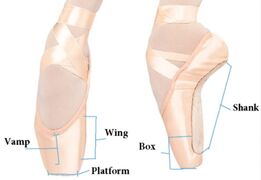|
12/3/2019 1 Comment Finding the Right Pointe Shoe With a vast number of various pointe shoes and styles, finding the right balance between shoe flexibility, correct fit, and support can be challenging. The shoes must have enough movement to allow the dancer to get fully onto the toe box in order achieve full plantar flexion. They must also have adequate support to allow the dancer to put full weight through the tips of the toes without collapsing. Without adequate support, the dancer will place excess load on the muscles, ligaments, and joints of the foot/ankle. Since pointe shoes have poor shock absorption, dancers must rely on good core stability and lower body strength to reduce the impact on the foot/ankle. Poor technique, fatigue, and improper fitting pointe shoes can increase the risk for injury. For example, the vamp of the shoe must match the foot shape. If the vamp is too low, the foot spills out of the shoe and loses stability. This can increase the risk for fracture at the midfoot or second metatarsal. If the vamp is too high, the dancer won’t be able to point the foot. Improper length of a pointe shoe can result in adverse consequences for a dancer: excess length of a shoe leads to instability and a short-fitting shoe can cause compression of the toes. The vamp/platform of the shoe loses its stability when the shoes have excess wear and tear, and dancing on dead shoes can increase the risk of stress fractures, ankle sprains, metatarsal/tarsometatarsal sprains, Achilles tendinitis, Flexor Hallucis Longus tendinitis, and injuries to the knees, hips, and spine. Next month’s post will feature Josephine from The Pointe Shop. She will provide more tips on finding the right pointe shoe. References: 1) “Principles of Dance Medicine, Functional Tests to Assess Pointe Readiness.” A webinar through the Harkness Center for Dance Injuries. Accessed Feb 23, 2017. 2)Shah S. Determining a Young Dancer’s Readiness for Dancing on Pointe. Curr. Sports Med. Rep., Vol 8, No. 6, pp. 295-299, 2009. 3) “Matching the shoe to the dancer.” A webinar through the Harkness Center for Dance Injuries. Accessed Nov 20, 2019.
1 Comment
|
CategoriesAll Cross Training Injury Prevention Nutrition Recipes Wellness Archives
October 2021
|
 RSS Feed
RSS Feed